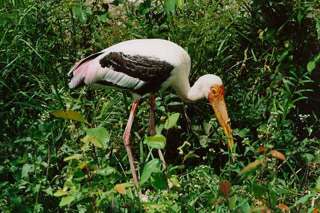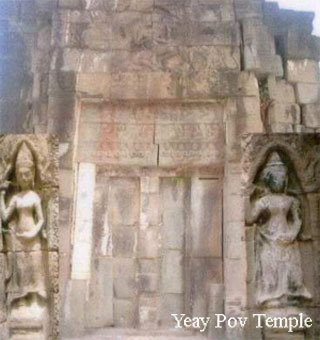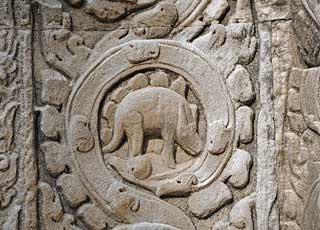Things to See and Do - Takeo, Cambodia
Ta Prohm Temple - Takeo

This temple, adapted from Bayon Style, was built during the late 12th and early 13th centuries, during the reign of King Jayavarman VII (AD 1181 - 1120) as a place of worship for Brahmans and Buddhists. The temple is 42 meters long, 36 meters wide and 11 meters high. Today the temple body, the gallery, the wal, the (gateway) and the moat surrounding the temple are heavily damaged. The temple was constructed of brick and laterite and devided into many rooms.
The outsite wall is decorated with bas-reliefs illustrating the Brahman story about the celestial nymph. Insite the temple are five rooms and a 13th century Buddha statue that faces east.Ta Prohm is the modern name of a temple at Angkor, Cambodia, built in the Bayon style largely in the late 12th and early 13th centuries and originally called Rajavihara . Located approximately one kilometre east of Angkor Thom and on the southern edge of the East Baray near Tonle Bati, it was founded by the Khmer King Jayavarman VII as a Mahayana Buddhist monastery and university. Unlike most Angkorian temples, Ta Prohm has been left in much the same condition in which it was found: the photogenic and atmospheric combination of trees growing out of the ruins and the jungle surroundings have made it one of Angkor's most popular temples with visitors.
After ascending the throne of Cambodia in 1181 A.D., Jayavarman VII embarked on a massive program of construction and public works. Rajavihara ("royal temple"), today known as Ta Prohm ("ancestor Brahma"), was one of the first temples founded pursuant to that program. The stele commemorating the foundation gives a date of 1186 A.D. The temple's main image, representing Prajnaparamita, the personification of wisdom, was modelled on the king's mother. The northern and southern satellite temples in the third enclosure were dedicated to the king's guru and his elder brother respectively. As such, Ta Prohm formed a complementary pair with the temple monastery of Preah Khan, dedicated in 1191 A.D., the main image of which represented the Bodhisattva of compassion Lokesvara and was modelled on the king's father.
The temple's stele records that the site was home to more than 12,500 people (including 18 high priests and 615 dancers), with an additional 80,000 souls in the surrounding villages working to provide services and supplies. The stele also notes that the temple amassed considerable riches, including gold, pearls and silks. Expansions and additions to Ta Prohm continued as late as the rule of Srindravarman at the end of the 13th century. After the fall of the Khmer empire in the 15th century, the temple of Ta Prohm was abandoned and neglected for centuries. When the effort to conserve and restore the temples of Angkor began in the early 20th century, the ?cole fran?aise extreme-Orient decided that Ta Prohm would be left largely as it had been found, as a "concession to the general taste for the picturesque." According to pioneering Angkor scholar Maurice Glaize, Ta Prohm was singled out because it was "one of the most imposing [temples] and the one which had best merged with the jungle, but not yet to the point of becoming a part of it".
Nevertheless, much work has been done to stabilize the ruins, to permit access, and to maintain "this condition of apparent neglect." As of 2010, however, it seems authorities have started to take a more agressive approach to restoration. All the plants and shrubs have been cleared from the site and some of trees are also getting removed. A crane has been erected and a large amount of building work is underway to restore the temple, with much of the work seemingly just rebuilding the temple from scratch as at other sites. Wooden walkways, platforms, and roped railings have been put in place around the site which now block some of the previously famous postcard photo opportunities. The design of Ta Prohm is that of a typical "flat" Khmer temple (as opposed to a temple-pyramid or temple-mountain, the inner levels of which are higher than the outer). Five rectangular enclosing walls surround a central sanctuary. Like most Khmer temples, Ta Prohm is oriented to the east, so the temple proper is set back to the west along an elongated east-west axis.
The outer wall of 1000 by 650 metres encloses an area of 650,000 square metres that at one time would have been the site of a substantial town, but that is now largely forested. There are entrance gopuras at each of the cardinal points, although access today is now only possible from the east and west. In the 13th century, face towers similar to those found at the Bayon were added to the gopuras. Some of the face towers have collapsed. At one time, moats could be found inside and outside the fourth enclosure. The three inner enclosures of the temple proper are galleried, while the corner towers of the first enclosure form a quincunx with the tower of the central sanctuary. This basic plan is complicated for the visitor by the circuitous access necessitated by the temple's partially collapsed state, as well as by the large number of other buildings dotting the site, some of which represent later additions. The most substantial of these other buildings are the libraries in the southeast corners of the first and third enclosures; the satellite temples on the north and south sides of the third enclosure; the Hall of Dancers between the third and fourth eastern gopuras; and a House of Fire east of the fourth eastern gopura.
Ta Prohm has few narrative bas-reliefs. One explanation that has been proffered for this dearth is that much of the temple's original Buddhist narrative artwork must have been destroyed by Hindu iconoclasts following the death of Jayavarman VII. At any rate, some depictions of scenes from Buddhist mythology do remain. One badly eroded bas-relief illustrates the "Great Departure" of Siddhartha, the future Buddha, from his father's palace.[5] The temple also features stone reliefs of devatas (minor female deities), meditating monks or ascetics, and dvarapalas or temple guardians. The trees growing out of the ruins are perhaps the most distinctive feature of Ta Prohm, and "have prompted more writers to descriptive excess than any other feature of Angkor." Two species predominate, but sources disagree on their identification: the larger is either the silk-cotton tree (Ceiba pentandra) or thitpok Tetrameles nudiflora, and the smaller is either the strangler fig (Ficus gibbosa). or Gold Apple (Diospyros decandra). Indulging in what might be regarded as "descriptive excess," Angkor scholar Maurice Glaize observed, "On every side, in fantastic over-scale, the trunks of the silk-cotton trees soar skywards under a shadowy green canopy, their long spreading skirts trailing the ground and their endless roots coiling more like reptiles than plants."
Map of Ta Prohm Temple
Other Attractions in Takeo
Phnom Ta Moa
Phnom Ta Mao is located in Tropiang Sap Villag, Tropiang Sap commune, Bati district, about 40 kilometers south of Phnom Penh, off National Road No. 2. Turn right at the sign and travel another 5 kilometers down a dirt trail. The site features mountains, the biggest national zoo and ancient temples. There are five mountains at this... read more
Ta Prohm Temple
This temple, adapted from Bayon Style, was built during the late 12th and early 13th centuries, during the reign of King Jayavarman VII (AD 1181 - 1120) as a place of worship for Brahmans and Buddhists. The temple is 42 meters long, 36 meters wide and 11 meters high. Today the temple body, the gallery, the wal, the (gateway) and the... read more
Phnom Ta Mao (Zoo)
Phnom Ta Mao (Zoo) is located in Tro Pang Sap village, Tro Pang Sap commune, Ba Ti District, Takeo province. Phnom Tamao can be accessible by the National Road No 2 in 40-kilometre distance from Phnom Penh. Then turning right more five kilometers by a trail, it takes 45-minute drive from Phnom Penh. Phnom Ta Mao is a varied site... read more
Wat Phnom Khliang
Wat Phnom Khliang, a Buddhist pagoda built in 1753, is a natural cultural site located in Prey Slek commune, Trang district, about 12 kilometers south of Takeo provincial town near National Road 2. It is a popular place for taking oaths and praying. During the Khmer Rouge regime it was used as a hospital. The red gravel at the foot... read more
Phnom Ba Yong
Phnom Bayang is located in Por Rorng village, Preah Bat Choan Chum commune, Kirivong district, about 43 kilometers south of Takeo provincial town or about 121 kilometers south of Phnom Penh. From Phnom Penh, take National Road 2 via Bati, Sam Rong, Daun Keo and Trang districts.Bayang temple was built between AD 615 and 635 by King... read more
Yeay Pov Temple
Yeay Pov temple is behind Wat Tonle Bati, about 100 meters from Ta Prohm temple. Constructed of sandstone in the 12 century, it is 7 meters square and faces east. Apart from the temple is a house on the bank of Tonle Bati, about 200 meters from the temple, that once was used by the royal family during holidays. Today this place... read more
Chup Pol Temple
Chup Pol Temple, Takeo, popularly known as Chu Pol temple, is a coveted tourist spot. Cambodia is famous for its historical sites and edifices and Takeo is no exception. Chup Pol Temple, Takeo is one such structure that throws sufficient light on the historical and cultural aspect of the place.Chup Pol Temple, Takeo is a sacred site... read more
Museum
Museum, Takeo is located in the Ang Kor Bo Rey District. It is the only museum in the province and was built by the EU organization. The Museum, Takeo is repository of many ancient items and relics of Phnom Da in 16th century. While researchers are intrigued by the display, the tourists are inquisitive and admire these... read more
Chruos Phaork
Chruos Phaork, Takeo is one of the well known nature and wildlife preserves in Cambodia. This serene and beautiful preserve is situated in the Pou Village in Preah Bat Choan Chum Commune. Chruos Phaork, Takeo is in fact located in the Kiri ong District which, in general, boasts of grand sceneries and lovely foliage. From the... read more
Neang Khmao Temple
Neang Khmao temple is located in Rovieng commune, Samrong district, off National Road 2, about 27 kilometers north of Takeo provincial town or about 52 kilometers south of Phnom Penh. This temple is inside Wat Neang Khmao.Constructed of sandstone and brick in the style of Koh Ker, the temple was built by King Jayavarman IV (AD... read more
Phnom Chiso (Chiso Mountain)
Phnom Chiso is a historical site located in Sia village, Rovieng commune, Samrong district, about 62 kilometers south of Phnom Penh or 27 kilometers north of Takeo provincial town. To reach the site, take National Road 2 to Bati district and Neang Khmao temple. Turn right at the sign for the site and head down the dirt trial for 5... read more
Angkor Borie
Angkor Borie is a town in the area of several ruins and archaeological digs. The area contains artifacts dating from the Funan (4th/5th century) and Water Chenla (8th century) as well as the later Angkorian period. The prasat ruins on top of nearby Phnom Da are 11th century Angkorian. There is a smalll museum in the town. read more
Phnom Da
Phnom Da is located in Prek Ta Phor village, Kork Thalork commune, Angkor Borei district, about 24 kilometers east of Takeo provincial town by water canal or about 102 kilometers south of Phnom Penh by the road. This part of the country is flooded six months of the year, during the rainyseason, and dry the rest of the year.Phnom Da... read more
Tonle Bati
Tonle Bati is a popular lake and picnic area that has bamboo shacks built out over the water that people can rent out for eating and whiling away the day. It's generally a weekend get-away spot, which means it?s nice and quiet during the week. Locals swim there, but the water does not look real inviting. There are all kinds of food... read more


.jpg)

















